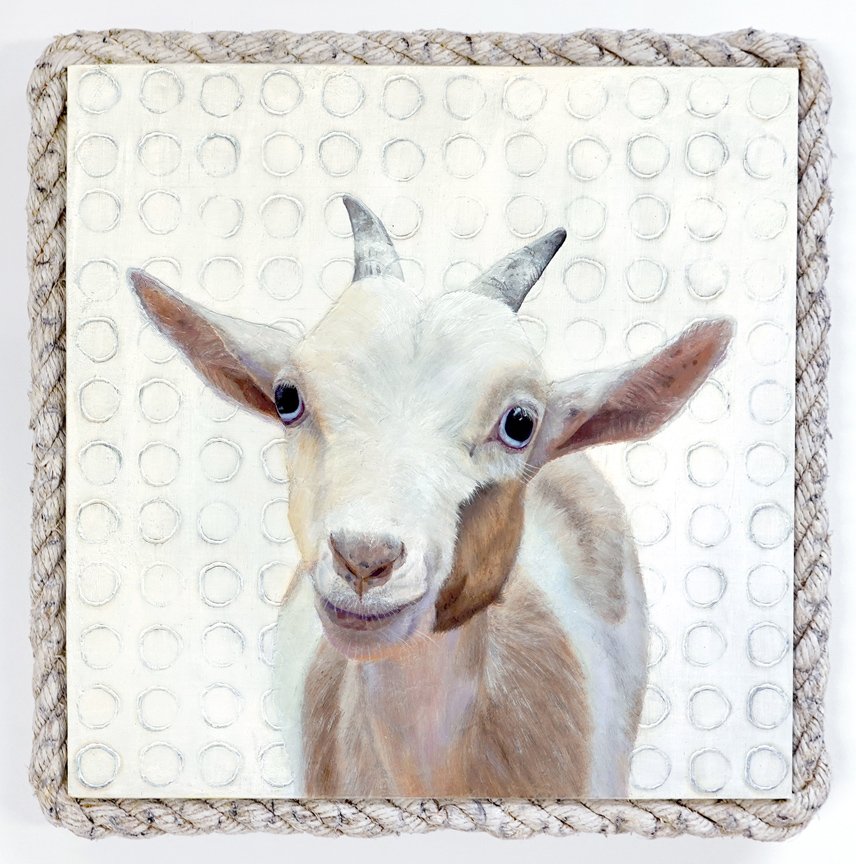And here are process pictures of Singularity from start to finish!
LSU Vet Med Artist Residency Artwork 5 Process
And here are process pictures of Singularity from start to finish!
mixed media artwork
And here are process pictures of Singularity from start to finish!
The adorable Nigerian Dwarf goat model is named Morticia, and she came into the large animal area in need of a Caesarean section. While she has been waiting for her labor to commence, she posed for me. The ways in which humans and animals coexist in domesticated relationships were inspiration for this piece.
Lineage is a mixed media painting incorporating goat halter rope, debudding tool marks, and acrylic on panel, 13.5x13.5x1.5", 2022.

As I mentioned in my first post about this painting, the coloration of the background comes from my novel usage of veterinary stains and medicine as art media, and I continued that color palette into the subject as well. However, there was a lot of trial and error in the creation of the background, and a cyan coloration that was produced ended up quickly going almost entirely fugitive (bleached out). I reinforced it with acrylic droplets as a final step, but as the painting continues to age, the background purple coloration is also beginning to fade. I may need to redo the whole background eventually, but right now I am adopting a wait-and-see approach!
This painting has already had a number of failed backgrounds, because two of the chemicals I tried to use for pigmentation clearly did not work from the start. The first I attempted was chlorhexidine, and the second was light green stain from Histology. “Wait a minute!” you might say to yourself. “Those chemicals are still listed in the mixed media!”
You’d be correct - I left them in because I kept sandwiching new chemicals between layers of acrylic medium, and I can’t be sure that some of those initial layers didn’t create the compositional effects that later resulted from the Diff-Quik methylene blue counter stain. That is the chemical that brought both the purple and strong cyan into to the background, but the cyan came from watering down or thinning out the stain and it began going fugitive quickly. The purple stuck around long enough that I thought it was permanent, but now it too is beginning to fade. I’ll continue to update you as to where this painting ends up, in terms of both aesthetics and process!
Here’s my second finished piece from my LSU Vet Med artist residency! I’m still mulling over the title - my current tentative selection is Wild Card, but I’m open to other suggestions.
I’ve met a lot of very cool animals here already, so this is high praise indeed - this is my favorite animal I’ve met thus far. ZooMed has a superstition they observe: you cannot name a wildlife patient, or its health will go downhill. This little fellow therefore doesn’t have a name, but he’s a real character. He has charisma and attitude in spades. When I arrived, he was a nestling and still had these “Einstein” feathers he’s rocking in the below image, but he’s now a fledgling and is getting closer to release every day!
I specifically chose the elongated landscape aspect ratio of this panel as mimicking the dimensions of the pathology slides. The coloration of the background comes from my novel usage of veterinary stains and medicine as art media, and I continued that color palette into the subject as well. However, as you’ll understand more clearly in the process post I’ll make soon, there was a lot of trial and error in the creation of the background, and a cyan coloration that was produced ended up quickly going almost entirely fugitive (bleached out). I reinforced it with acrylic droplets as a final step.
This is a mixed media painting of a wild brown thrasher nestling including Clinical Pathology's Diff-Quik methylene blue counter stain, Histology's light green stain, ZooMed's chlorhexidine antiseptic, and acrylic on basswood panel, 10x20x1.5", 2022.
